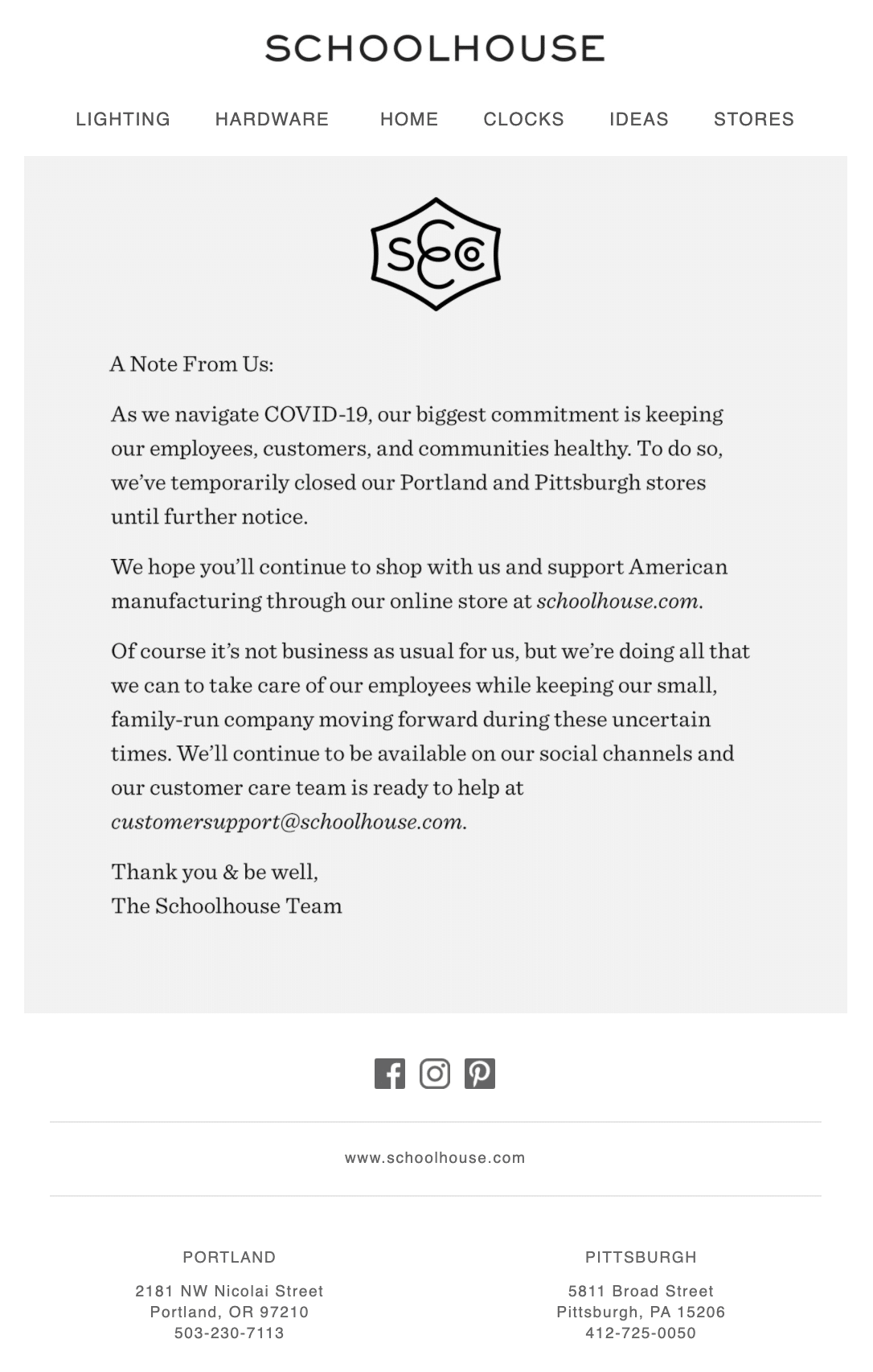Right now your subscribers are being bombarded with emails about COVID-19—from their local supermarket, pet store, doctor, restaurant, gym, the list goes on.
As business leaders and marketers, you’re carefully considering whether to send your own email regarding COVID-19. For many of you, it may look like an official letter signed by the CEO of your company. For others, it may look more like a quick update to notify subscribers of up-to-date changes.
The bottom line: If your COVID-19 emails aren’t evaluated with importance and consideration, then, at best, you may find your brand and message ignored in currently over-crowded inboxes. At worst, you may get backlash from your subscribers if your messages are deemed inappropriate or profiteering.
In order to help you navigate this uncertain email landscape, we’ve gathered some examples of coronavirus emails from our own inboxes, and cited some comments from people on Twitter to give anecdotal insights into your subscribers’ reactions. We hope you can use these insights to consider how you should or should not be communicating. And, in turn, to help your own audience in a universal time of need.
When should I send an email about COVID-19?
If your product or services are impacted by COVID-19, then your customers would probably appreciate an email update.
Here are a few good reasons why you might need to send a coronavirus-related email:
- You have useful, meaningful information to share.
- You have customers that may be more sensitive to this crisis (e.g. therapists sending support to their clients, or assisted living practitioners informing relatives of loved ones).
- You have brick-and-mortar locations (or you expect to see customers in person).
- Your services have been impacted or changed in some way.
- You’re doing something to help your customers during this unprecedented time, such as providing food or health supplies, offering virtual services, waiving cancellation fees, etc.
The only “how we’re handling COVID-19” email I care to receive from a company, is the one I haven’t yet from @Expedia.
Getting emails from every other company that I haven’t done any bookings with, but not you guys? Never want to book with you again. So disorganized!— Alessia (@alesssia) March 15, 2020
Update your audience about rapid changes with Campaign Monitor’s crisis template.
Deciding whether to send a crisis email is never easy—but the design process should be. Our email design team created a crisis template for those moments when you’re down to the wire, feel urgency to send a crisis message, and need to make it count.
Try out the template for yourself and see how quickly it can work for your brand.
When should I re-think sending a COVID-19 email?
For every useful COVID-19 email, there are a dozen which probably did not need to be sent. When sending a coronavirus email, it’s best to ask yourself why you’re sending it and who really needs to receive it. Just because someone purchased something from you five years ago doesn’t necessarily mean they need to know that you’re adding extra hand sanitizer to your checkouts, or that you’re still operating as usual (unless that would come as a surprise).
Here are the types of COVID-19 emails that may get your subscribers upset with you:
- You just want to look like you’re doing something or responding in some way, but don’t have anything planned.
- You want to tell people that COVID-19 isn’t going to impact your service.
- You want to tell subscribers that your office staff is going to work from home.
- You have no new information to share.
- You don’t have anything valuable to share, but everyone else is doing it.
- You are simply restating information from other sources, over topics which you aren’t an authority.
To the dozens of companies that have sent out COVID-19 emails to their “communities”, I haven’t read a single one of your emails.
However, it’s been a great reminder of all of the email lists that I need to unsubscribe to.
So, thank you.
— Parker Ehret (@parkerehret) March 15, 2020
5 ways to make your COVID-19 email effective
We’ve all received dozens of COVID-19 emails by now. It’s safe to say many of us find some to be helpful, and some to take up valuable space in our inboxes.
Since most people don’t have (or won’t give) that much time to read these emails, it’s key to go through the considerations above, while also taking every step possible to make every message one that your subscribers will engage with. It’s an important time, and, if you’ve decided to send something, then you definitely want it to be read and engaged with.
So here are our tips on how to effectively get your important COVID-19 messages across to your audience.
1. Only include genuinely useful content.
Please don’t send a COVID-19 email just because everyone else is doing it. Do it because you have something insightful and useful to say.
It could be tips on how to work from home, a reminder of virtual services you offer, or an update to your returns or delivery options. Think about your customer first, and your business second, to determine what information you can provide that they’ll be happy to receive.
That’s why we like this email from CVS, which reminds their customers that they offer a variety of tools and services that can be used remotely.

2. Make your emails easy to skim.
Most COVID-19 emails seem to contain a solid wall of plain, unformatted text, making it very hard to determine what the key points are, and if those key points are important or not.
This example from Lyft stuck out to us, which has large titles and nicely spaced and bulleted key points, making it super easy to skim through.

Also note: It makes sense to get this email from Lyft. Their entire business is based on very close interaction between multiple people, so their customers will obviously have big questions about how Lyft is treating this service in the context of social distancing.
3. Keep it concise.
Many COVID-19 emails feature a large amount of superfluous words and technical jargon. However, your subscribers are probably very busy (and mentally overwhelmed) and would much prefer a concise message written in plain english.
That’s why this email from Schoolhouse was noteworthy, as it clearly explains what the issue is, how they’re addressing it, and points customers to where they can continue to interact with their brand and get support if they need it.

4. Add a note about the virus to your existing newsletter.
In many cases, you may not need to send a dedicated COVID-19 email, but simply add a note to the top of your next newsletter. General Assembly sent a dedicated COVID-19 email, but is also reminding its students that classes will now be online at the top of their regular newsletters.

5. Ask your subscribers what they think.
Too many brands are sending their obligatory COVID-19 email and then get back to regular business like nothing is happening. Reformation took a moment to say that they’re not sure what is appropriate for their company to be talking about right now, and they ask subscribers what they think: “Do you still want to hear about new collection launches and sustainability-related stuff? Or do you need a break? Please let us know.”

Other things you should be thinking about in light of COVID-19
Cancel existing campaigns that don’t make sense in the current environment.
Do your scheduled promotions and newsletters make sense in the current environment? If you’re asking your subscribers to gather in large crowds or travel, consider following the World Health Organization’s recommendations and canceling events and large gatherings, and to pause promotions that may conflict with hygiene guidelines.
Spirit Airlines found this out the hard way when a pre-scheduled promotional email saying “Never A Better Time To Fly” was sent concurrently as COVID-19 was upgraded to pandemic status.

We apologize for the email that was sent earlier today. It was written prior to the current situation and unfortunately sent. We are closely monitoring COVID-19 and taking precautions to keep our Guests & Team Members safe. pic.twitter.com/6SGdfghAe9
— Spirit Airlines (@SpiritAirlines) March 12, 2020
Don’t forget about your automated emails.
It’s easy to forget about those automated emails which may not make sense during this time, especially if you operate a brick-and-mortar business which traditionally encourages customers to come to the store.

Wrap up
COVID-19 is nothing to take lightly, as anxieties are high and people are worried. Both lives and livelihoods are at risk around the world, and extra caution is therefore required.
To make sure you’re giving it the right concern, not only should your messages express appropriate sentiment, but they should also be clearly helpful and supportive in this time of crisis. Think about your subscribers, the inundation their inboxes are under right now, and how you can be helpful, supportive, and a breath of fresh air.
If you’re looking for more helpful tips about marketing during COVID-19, subscribe to our weekly newsletter, where we’ll be sending you the latest content we’re working on.






